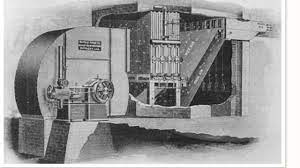History Of First Air Conditioner, The history of air conditioner started in the early days with the need to preserve foods. Foods that are kept at room temperature spoil easily due to the growth of bacteria. At temperature below 4°C (40°F), the growth of bacteria is reduced rapidly. As a result of the development in food refrigeration, other applications that follows include air conditioning, humidity control and manufacturing processes.

The discovery of the principles of the absorption type of refrigeration in 1824 showed that liquefied ammonia could chill air when it is allowed to evaporate. Ice was created using compressor technology in the year 1842 by a physician named John Gorrie.

The commercially available of air conditioning applications started based on the need to cool air for industrial processes than for personal comfort. The first electrical air conditioning was invented by Willis Haviland Carrier in the year 1902. He was also known as the Father of Modern Air Conditioning.
His invention was designed to improve the manufacturing process of a printing plant. By controlling the temperature and humidity of the plant, the processes were made more efficient as the paper size and the ink alignment were consistently maintained.
The Carrier Air Conditioning Company of America was established by him to meet the demand of better productivity in the workplace. Today, Carrier Corporation is the biggest air conditioner manufacturer and marketing corporation in the world in central air conditioning.
The discovery of Freon in 1928 by Thomas Midgley, Jr., a safer refrigerant to humans compared to the toxic and flammable gases such as ammonia, propane and methyl chloride sparks the invention of air conditioning systems for residential, industrial and commercial applications.
Unfortunately, the use of CFC and HCFC refrigerants are causing the depletion of ozone layer in our atmosphere that is causing harmful rays to penetrate our earth. Newer ozone friendly refrigerants have been developed to replace refrigerants such as R-11, R-12 and R-22 to name a few. Non-ozone depletion refrigerant such as R-410a has been used in newer air conditioning systems.
History Of Air Conditioner and Refrigeration
- 1820 Ice was first artificially made as an experiment.
- 1824 Michael Faraday discovered the principles for the absorption type of refrigeration.
- 1834 Jacob Perkins invented the first artificial ice manufacturing machine which led to our modern compression systems.
- 1902 Willis Haviland Carrier invented the first air conditioner to control the temperature and humidity of a printing company, marking the first time effort taken to control the temperature of the surroundings. This starts the history of air conditioning.
- 1906 Stuart W. Cramer come out with the term “Air Conditioning.” which was later adopted by Carrier.
- 1913 The first international refrigeration expo is held in Chicago.
- 1928 The discovery of Freon refrigerant by Thomas Midgley, Jr.
- 1930 The White House is air-conditioned.
- 1946 The demand for room air conditioners began to increase with more than 30,000 units produced on this year.
- 1953 Room air conditioners sale exceed 1 million units. This is another key milestone in the history of air conditioner.
- 1953 The Refrigeration Equipment Manufacturers Association and The Air-Conditioning and Refrigerating Machinery Association are formed.
- 1957 The first rotary compressor was developed hence making air conditioning units smaller and more efficient compared to the reciprocating type.
- 1977 Heat Pumps equipment developed that allows cooling and heating cycle using the same machine that can be used to provide cooling during summer and heating during winter.
- 1987 Montreal Protocol signed to protect the earth’s ozone layer is signed in Montreal, Canada. The Protocol establishes international cooperation on the phase out of ozone depleting substances, including the chlorofluorocarbon(CFC) refrigerants used in HVAC equipment.
- 1990 Microprocessor control systems are used in all areas of refrigeration and air conditioning due to the readily available semiconductor technology.
- 1992 The R-22 Alternative Refrigeration Evaluation Program (AREP) starts to find alternative refrigerants to R-502 and R-22.
- 1995 Chloroflourocarbon (CFC) manufacturing in the USA ends on December 31.
- 1997 Kyoto Protocol signed to protect the earth’s climate by reducing greenhouse gases that cause climate change.
- 1998 Unitary air conditioners and heat pumps set a sale record of more than 6 million units.
- 2007 A State Council issued a circular to restrict the temperature of air conditioning in public buildings to 26°C (78°F) or higher during summer and 20°C (68°F) and lower during winter. Sale of low efficiency air conditioning units are also outlawed.






